Side Menu:
Fourth Officer Joseph Boxhall
- A Night to Remember
Until 1958, the sinking of the Titanic was a night to forget for Joseph Boxhall. And then something changed.
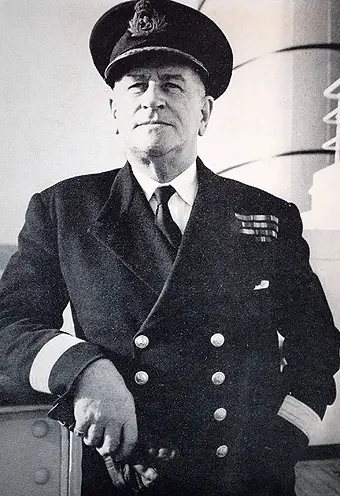
Commander Harry Grattidge
Boxhall, often described as a rather quiet, taciturn man, was a friend of Commander Harry Grattidge, who had commanded the Queen Mary and Queen Elizabeth. There was a strong Titanic connection - one of Grattidge's first Cunard ships was the Carpathia where he was Fourth Officer in 1914, only two years of the sinking of the Titanic. And then after the war Grattidge moved up to third officer aboard the Mauretania, whose captain was Sir Arthur Rostron, who had earned his title on account of rescuing Titanic survivors when he was captain of the Carpathia. He had also been chief officer during the sinking of the Lancastria on the 17th of June 1940, off the French port of St. Nazaire, with an estimated loss of life of between 3000 and 5,800 fatalities - the largest single-ship loss of life in British maritime history. Grattidge was also captain of the Aquitania, which Boxhall had served aboard in the 1930s. Also Grattidge served aboard the RMS Scythia in the early 1940s, at approximately the same time as Boxhall was chief officer aboard her in 1940 before retiring.
It is thus not surprising then that Boxhall, when asked to act as a technical advisor to the 1958 film "A Night to Remember", based on Walter Lord's 1956 book of the same name, he asked his friend Grattidge to work with him on the project as he was experiencing some health problems. Members of his family were surprised when Boxhall agreed to assist in the making of the film, as he had been rather reluctant to speak on the subject of the disaster.
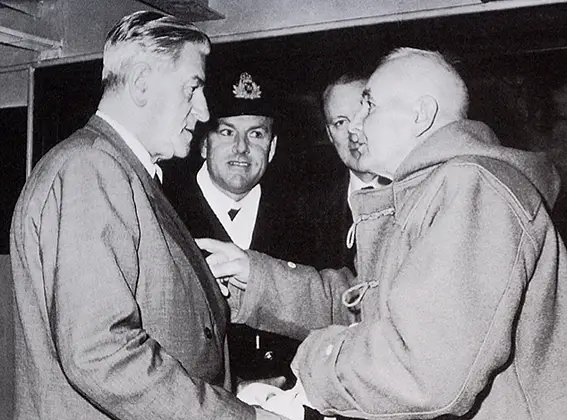
Harry Grattidge (left) on the set of the film "A Night to Remember" with actor Kenneth More (in costume as Second Officer Charles Lightoller) and Joseph Boxhall (right).
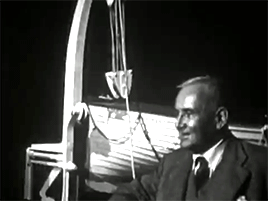
Boxhall on the boat deck set of
"A Night to Remember" (1958)
Years earlier he had refused to be involved in Walter Lord's research for his book "A Night to Remember", reservations apparently stemming from the author's surname and possible connection (he suspected a link with Stanley Lord, and had strong feelings on the subject of the Californian). But it seems Grattidge prompted him to take on the role: "It took two months and the diplomatic visit of an old seafaring friend to persuade him to have anything to do with it. Even then he would not spend a night away from Christchurch." (May 1959, Nautical Magazine)
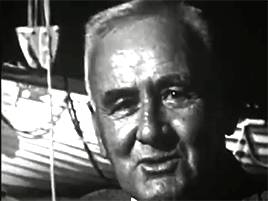
Boxhall talking on the boat deck set
of "A Night to Remember".
It was also perhaps the urging of his niece that prompted him to take the step. Titanic author and researcher Inger Sheil writes: "He surprised his family by agreeing to participate in the filming of ANTR (his niece had asked him to do so, telling him it was his duty to 'see the poor ship sunk properly'). Although he had always been reluctant to talk about the sinking, he seemed to open up somewhat about this time - one family member told me involvement in the film gave him a new lease on life and he was actively involved in promoting ANTR." (Inger Sheil, Encyclopedia Titanica).
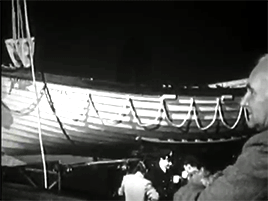
Boxhall on the boat deck set of
"A Night to Remember" (1958)
Boxhall also visited the set during the making of the film, along with his niece who had convinced him to work on the film and who was a friend of Kenneth More before his film career took off. There are several photographs and film of Boxhall on set. In one, he is seen chatting with Commander Harry Grattidge, pointing at him while an eager looking Kenneth More, who portrayed Second officer Lightoller, looks on.
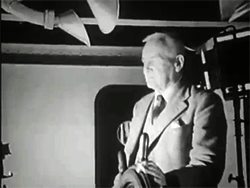
Boxhall visits the bridge set
of "A Night to Remember"
There is moving footage of him talking on set, looking at the lifeboats and then talking to camera with a lifeboat behind him. Even more poignant, he is seen on the set of the bridge, turning the ship's wheel. He later mentioned: "I've a great admiration for those film chaps who had to endure each shot being taken three times over in cold October whilst floundering about in Ruislip Reservoir" (May 1959, The Nautical Magazine)
In another photograph he is seen pointing at a model of the Titanic as used in the film. He seems to be pointing out something on the roof of the bridge.
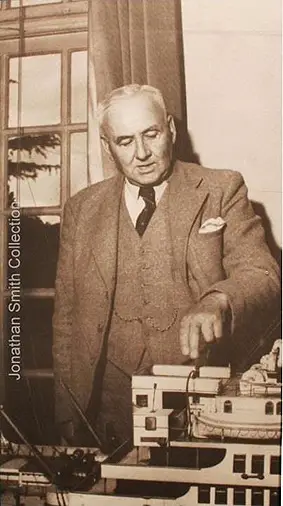
Boxhall pointing to a Titanic model used during
the making of "A Night to Remember",
- Jonathan Smith Collection. (Click to enlarge)
And in a moving photograph he is seen at a private screening of the film, watching with his legs crossed as the portside of the Titanic is seen sinking with lifeboats in the foreground. He must have recalled what he had seen from the vantage point of his lifeboat no.2 when he watched the starboard side of Titanic as she sank.
Boxhall's name features prominently in the film credits, with a large caption stating:
"The producers gratefully acknowledge the assistance of Captain Grattidge, O.B.E, Ex-Commodore of the Cunard Line, of Commander Boxhall, who was 4th officer of the Titanic, and of many survivors of the disaster who recalled their personal experiences."
After seeing the film he later "admitted he was not too displeased with the result and commented on the fabulous amount of money that was spent on technical equipment... In answer to a question concerning the harrowing scene presented in the film of third-class passengers clamouring to get through a closed sliding gate aft, he said it may or may not have been true. American immigration laws insisted on this gate; if it had not been there, no immigrants would have been allowed to land. At night it was opened to allow the crew to wash down, but whether it had been closed again on this particular night he could not say." (May 1959, The Nautical Magazine)
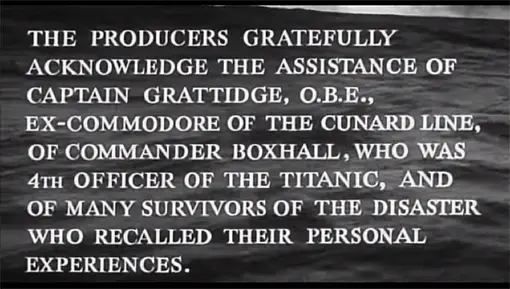
Boxhall's credit during the introductory scenes of the British film
"A Night to Remember" (1958)
He was involved in the promotion of the film and attended the premiere at the Odeon Theatre in Leicester Square, on Thursday, 3 July 1958 where he is photographed wearing a black bow tie and talking to producer William MacQuitty (who witnessed the actual launch of the Titanic on May 31, 1911, when he was a boy) along with fellow surviving Titanic officer Herbert Pitman.
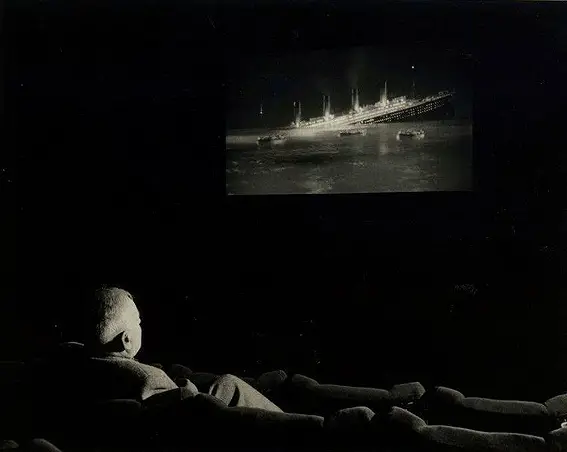
Titanic's 4th Officer Joseph Groves Boxhall during a private screening of "A Night to Remember". (Click image to enlarge)
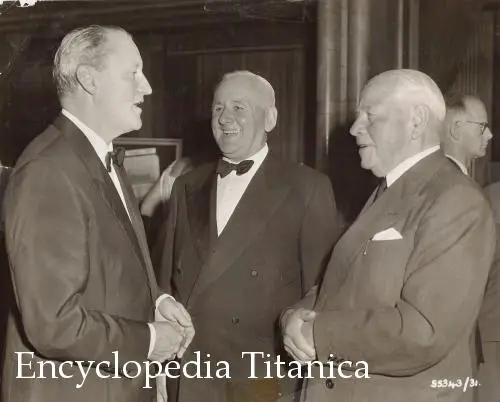
Taken at the "Odeon" Leicester Square London July 3rd 1958 during the premiere of "A Night to Remember". Herbert Pitman is on the far right, talking to the film's producer William MacQuitty (left) and Boxhall in the middle. (Encyclopedia Titanica)
Boxhall was also photographed at what is possibly the New York premiere of "A Night to Remember" on Tuesday 16 December 1958, wearing a black bow tie, the same as the London premiere.
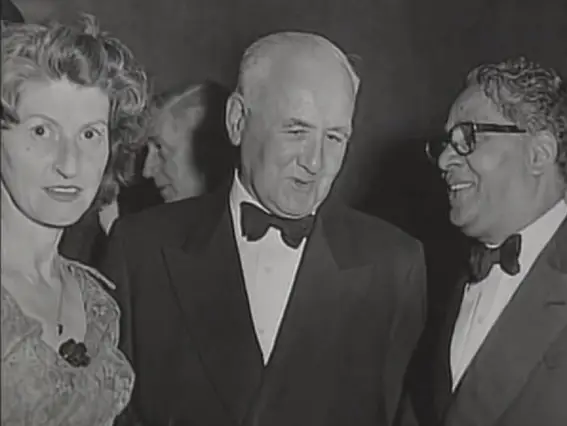
Boxhall at the premiere of "A Night to Remember" - possibly in New York, 1958.
The Chattanooga Daily Times (Chattanooga, Tennessee) also covered Boxhall's involvement in the film:
Relives Memories
Forty-six years ago, Joseph G. Boxhall was on board the sinking liner Titanic as a member of that ship's crew. Today. Cmdr. Boxhall is reliving his memories of that historic event by being technical adviser on the film of the Titanic disaster—the Rank Organization's production of "A Night to Remember." (The Chattanooga Daily Times, 23 Nov 1958)
Here is a video clip of Boxhall on the set of "A Night to Remember":
Note: I recommend watching the film in "Full Screen Mode." To activate "Full Screen Mode," you need to click on the video title which will take you to YouTube and then click on the lower right hand box.
1959 Christchurch Talk
In 1959 Boxhall gave a talk at the Christchurch Red House Museum, which was attended by a William Sandrey who wrote it up into an article entitled "A Talk by the Fourth Officer of the Titanic" that appeared in the May 1959 edition of the Nautical Magazine on pages 262-264.
A full version of the article can be read here (courtesy of Brown, Son and Ferguson Ltd):
"A Talk by the Fourth Officer of the Titanic"
Sandrey described Boxhall as "a spritely 74" and goes on to retell the events in a manner that closely resembles his testimony at the US and British Inquiries, although he goes a step further in his condemnation of the Californian, saying:
"The ship on the port side was now clearly visible with portholes brightly shining, and contrary to the master's later given evidence, was still moving slowly. And when this ship, the Californian, arrived in port, the master decided not to make any report on the night's happenings; and if it had not been for a donkey-man who left her upon arrival, it is doubtful if she would ever have been identified… In a few concluding words he again commented upon the great tragedy; the failure of the Californian to answer their distress signals. 'The night was so calm,' he said, ‘they could have come alongside and put a gangway aboard.' …just across the water blinking at him were the lights of a ship which in less than half-an-hour could have saved them all. " (May 1959, The Nautical Magazine)
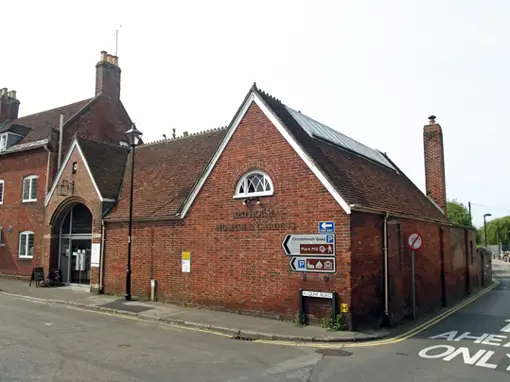
The Christchurch Red House Musuem where Boxhall gave a talk on Titanic in 1959. (Source: Google Streetview)
However, this emphasis on the failure of the Californian elicted a "correction" and "unreserved apologies" a month later in the June 1959 edition of the Nautical Magazine, after being sent evidence that Boxhall's description of the Californian "still moving" and later not reporting the event were not true:
A Correction.
A TALK BY THE FOURTH OFFICER OF THE "TITANIC."
In the last issue of the Nautical Magazine an article by Mr. William Sandrey reporting an address by Commander Boxhall, ex-fourth officer of the Titanic, contained the following paragraph:
"The ship on the port side was now clearly visible with portholes brightly shining, and contrary to the master's later given evidence, was still moving slowly. And when this ship, the 'Californian' , arrived in port, the master decided not to make any report on the night's happenings; and if it had not been for a donkeyman who left her upon arrival, it is doubtful if she would ever have been identified."
Evidence since put before the Nautical Magazine proves conclusively that, in fact, the master of the Californian was in wireless communication with his owners (the Leyland Line), with relatives of those lost in the Titanic, and with the American Press before the ship's arrival in Boston. In addition, independent contemporary documents support the view accepted by the British Court of Inquiry that on the night in question the Californian lay stopped from 10.21 p.m. to 6 a.m.
Despite the adverse findings of the British Court of Inquiry, the question of whether or not the Californian could, in fact, have rendered any assistance to the survivors of the Titanic has been the subject of controversy for over 40 years. Nevertheless, in publishing the above correction, the Nautical Magazine is able to tender its unreserved apologies to anyone to whom distress might have been caused by the unfounded reflections on the character of the master of the Californian contained in the article referred to above. (Nautical Magazine, June 1959 issue on page 326.)
1961/1962 letters
In 1961 and 1962, 77-year old Joseph Boxhall corresponded with 34-year old Joseph Carvalho of Winchester, Massachusetts, USA (May 4 1927 - March 17 2017). Joe would later go on to help form the "Titanic Enthusiasts of America" (TEA) in 1963 (changed to "Titanic Historical Society" in 1975). Joe was a model builder and produced a large Titanic model from scratch back in the 1950s which appeared in Popular Mechanics magazine. All five letters from Boxhall were written on thin blue airmail self-folding stationery, with a blue ink ballpoint pen with a red sixpence stamp featuring the Queen and Parliament. With the address: J.G. Boxhall Commdr. RNR Ret. 11 Walcott Avenue Fairmile Christchurch Hants. England.
All the letters written by Boxhall can be viewed in transcription form here:
Boxhall's 1961 - 1962 Letters
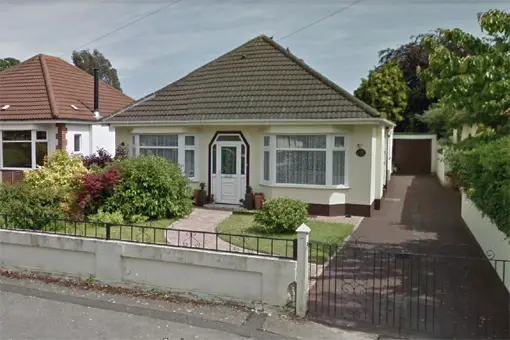
11 Walcott Avenue, Christchurch, as it looks today. (Source: Google Streetview)
Some key points of interest:
-Boxhall never made a model of a ship due to a lack of patience
-At 77 he spent most of his time sleeping and reading
-18th/19th of March 1961, widower Third officer Pitman visited him out-of-the-blue along with his nephew and wife (Pitman died 9 months later in December)
-Visited Boston along with his father when he was Captain of the S/S Alecto when he was 10/11. He was sea sick during the journey but enjoyed July 4th celebrations in Boston
-50th sinking anniversary he described as "revived this terrible tragedy and I think it rather sad that it should all be churned up again"
-Described seeing "one body of a man floating on his back in a dinner jacket"
-He was experiencing financial problems as he describes his "rapidly diminishing capital" and efforts to save money on postage.
1962 BBC Radio Broadcast
Originally broadcast 22 October 1962, when Fourth officer Boxhall had retired and was 78 years old. His interest in retelling the Titanic story was spurred by his unexpected involvement in the making of the 1958 film "A Night to Remember" 4 years earlier. He had also been involved in the writing of an article published in the May 1959 edition of Nautical Magazine and had been writing letters to a Mr. Joe Carvalho of Massaschusetts, USA beginning in 1961. He died five years after this broadcast in 1967. Although the official cause of death was "cerebral thrombosis" his health had been deteriorating during the 1960s and the family believe he was suffering from alzheimers or senility. This must be taken into account when examining this broadcast.
Here is a video with audio from Boxhall's 1962 BBC Radio broadcast:
Note: I recommend watching the film in "Full Screen Mode." To activate "Full Screen Mode," you need to click on the video title which will take you to YouTube and then click on the lower right hand box.
Some interesting notes to look out for:
1. There is the curious acknowledgement that he "was sitting in my cabin having a cup of tea" when he heard the bells warning of an object ahead. Boxhall's shift did not finish until midnight, so what was he doing in his cabin? Some have speculated that he was ill, while others says it was a cover for being in the lavatory.
2. He says that First officer Murdoch told Captain Smith he ordered "Full Speed Astern, Sir, on the Port Engine" which does not align with what he said at the US and British Inquiries, where he said he ran "the engines full astern" (US Inquiry) "reversed the engines" (British Inquiry).
3. At the British Inquiry he said "I do not remember any gangway doors being open". However, in this broadcast he admits that "I found that there was such a mob standing in the gangway doors" - in other words they were open.
4. After the strongly worded correction that followed the publication of a talk Boxhall gave in 1959 (May edition of the Nautical Magazine), in which he described the failings of the Californian, it is interesting to note that two years later he does not directly implicate the Calfornian as the 'mystery ship', other than mentioning at the end of his broadcast that the ship was in the area and "I don't remember seeing any other ships" - a subtle implication.
Titanic author Inger Sheil also recommends caution, due to his health: "It comes with all the usual caveats about later eyewitness recollections. Additionally, towards the end of his life he suffered from a form of dementia - his niece recalled visiting him and noticed that his memory wasn't what it had once been, but I'm not sure how long before he passed away in 1967 it started affecting him. I notice there are some interesting errors - e.g. he mentions Moody being on the Carpathia and standing watches with him. I wonder if that was the effect of his memory issues combining with the past distress of arriving on the Carpathia and finding Moody hadn't made it. " (Inger Sheil, Encyclopedia Titanica)
A transcript of Boxhall's BBC Radio broadcast can be viewed in its entirety here:
Boxhall's 1962 BBC Radio Broadcast
Financial Difficulties and Californian
As referenced in his letters of 1961, Boxhall was experiencing financial problems as he describes his "rapidly diminishing capital" and efforts to save money on postage. Leslie Harrison, in Titanic Myth Part 2, refers to Boxhall applying to the MMSA (Mercantile Marine Services Association) for financial help. In Paul Lee's book "The Titanic and the Indifferent Stranger" he also references financial assistance from the MMSA and how Leslie Harrison had been in contact with Boxhall regarding the Californian allegations:
Boxhall of the Titanic was another of Harrison's contacts. As a retired seafarer, Boxhall had already been in touch regarding financial assistance from the M.M.S.A. But Harrison was not averse to a subtle form of menace in his dealing with the ex-4th Officer. For instance, in 1963, the M.M.S.A. Secretary was assisting the BBC in a radio dramatisation of the Californian incident. Realising that the press might pester survivors of the disaster, he wrote to Boxhall, "I am quite prepared to tell [the press] that so far as you are concerned personally, you have never gone deeply into the technical questions which may or may not prove that the Californian was the ship involved, and consequently that you have an open mind on the subject. Further, I would add that you have nothing more to say about the incident than is contained in the evidence you gave at the American and British inquiries, and that you wish to be spared any further strain, having regard to your advancing years and ill-health. If you feel that the above accurately represents your attitude towards [the Californian], then I am prepared to give you my personal assurance that I will do everything possible to divert unwelcome attention from you." Harrison also offered to send him copies of some of his documents "for [Boxhall's] private use [and which are not] intended as material which might influence you to express support for our efforts." Boxhall's anti-Californian sentiments were well known, but he replied, as he always did, in a cheery, acquiescent manner. One can only imagine what would have happened if Boxhall had disagreed with Harrison and made public statements against Captain Lord! ("The Titanic and the Indifferent Stranger" by Paul Lee)